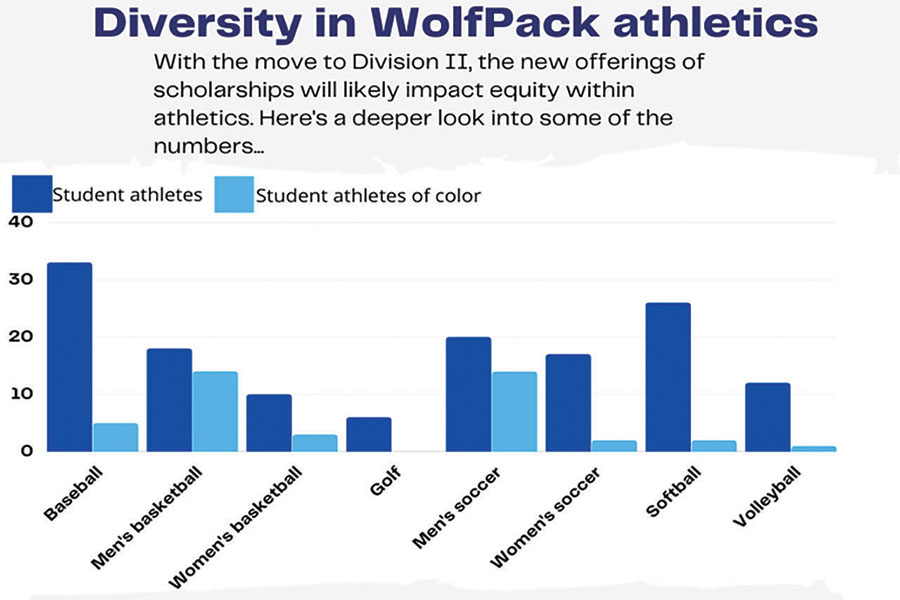Madison College athletics moving to Division II
Change allows scholarships in all sports, making athletics more accessible
March 22, 2022
Representing WolfPack athletics is not an easy feat. During their season, athletes are spending about 20 hours per week practicing, competing and traveling. Tournaments can span entire weekends and away games have players riding the bus late into the night.
In order to be eligible to play, athletes must be full time students. Not only that, but they have to maintain good grades to stay eligible.
Because of the time commitments to being a full time student and athletic obligations, little time is left for work. This can put athletes in a tight spot where many already struggle. In 2019, the NJCAA found that 37 percent of athletes come from households earning $20,000 or less a year.
Most athletes represent Madison College without any financial help. All of the sports except for baseball and softball currently compete at the NJCAA Division III level, meaning no athletic scholarships are given. Baseball and softball have been playing at the Division II level and receiving athletic scholarships since 2000 and 2014, respectively.
But starting next season, Madison College athletics are moving to a whole new level. All sports will compete at the NJCAA Division II level. This shift greatly affects returning and future student athletes in many ways.
“It provides access,” said Steve Hauser, athletic director. “It’s not going to cost more in terms of the teams that we play and it provides better competition, which we’re really excited about.”
One of the main differences between Division II and III is that the higher the division, the more scholarship money can be offered to athletes. Scholarships can be used for tuition and books, but not for room or board.
The school hopes to have at least $200,000 available for scholarship funding, which equates to 32 full ride scholarships. Each coach will be allotted a certain amount of money that they can use however they see fit. Full ride scholarships could be offered to a couple select players or be divided into multiple smaller scholarships.
This money comes from funds raised by the athletic office. Some of it comes from ticket and concession revenue, while some of it comes from training camps that the school hosts.
The idea of Madison College athletics making this move has been in the works since 2014. There were a couple different reasons why the shift was finally made, most of which relate to accessibility.
Many of the schools Madison College currently plays are also moving to Division II. Because of this, scheduling would become incredibly difficult had the switch not been made.
The WolfPack will still travel mostly to Illinois for games. Travel costs will remain relatively the same, as will travel times. The main difference is teams that would usually be played just in tournaments will now be conference rivals.
Another perk for athletes is they’ll be facing higher levels of competition.
“As a student athlete…we want you to have the best experience you can have. We want you to participate against the best teams possible because it does make a difference,” said Hauser. He also noted that playing against the higher ranked teams will provide athletes hoping to move on to a four year school more exposure to coaches.
The new division change also hopes to attract more students, especially from underrepresented communities. One goal is to have at least 20 percent of the 32 scholarships awarded to athletes of color.
For the 2020-21 season, the athletics diversity was similar to the overall Madison College student body, not including esports. It found that 28.9 percent of athletes are from communities of color. Data from the athletics department showed that 26.1 percent of all Madison College students are diverse.
However, the only teams that had over half of their athletes from diverse backgrounds were men’s basketball and men’s soccer, with 14 athletes each. Baseball came next with five players of color on a roster of 33.
Five of the sports offered had over half of the athletes on the team qualifying for FAFSA.
Having the scholarships available should help the college recruit and retain athletes of color.
“This gives us an opportunity to, for example, attract a basketball player that now would typically go to Illinois if they’re going the junior college route and receive aid where maybe they’ll stay home if we’re able to help provide assistance financially for their tuition,” said Hauser.
This move will not affect esports, as they currently don’t get scholarships. However, they can compete in leagues that offer cash prizes which other athletes can’t do. If an esports player wins, they get to get half of the prize money and the rest goes to the program.































